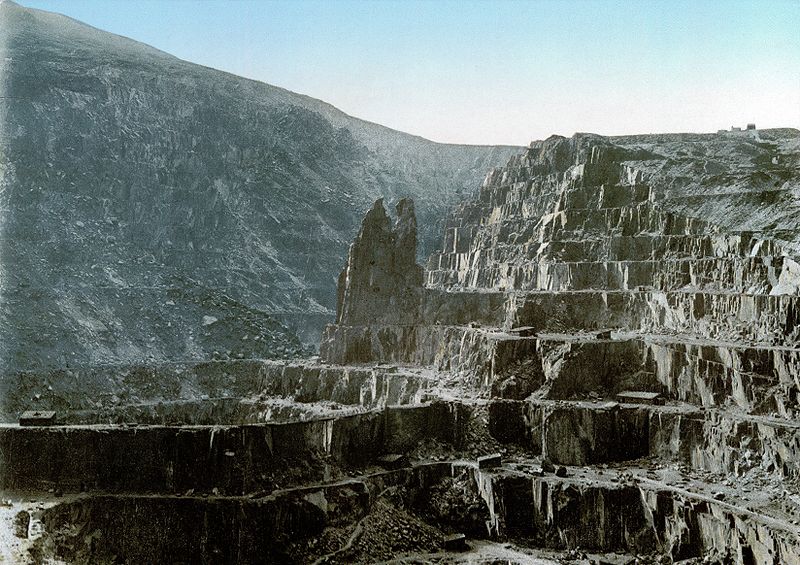Penrhyn Quarry

It was Richard Pennant (1737? -1808) who first set
the slate industry on its entrepreneurial phase. Though of
Flintshire lineage, Richard Pennant was a Liverpool merchant prince
who founded his fortune on the slave trade and inherited estates in
Jamaica. On December 6, 1765 he married Ann Susannah, daughter and
heiress of General Hugh Warburton (1695-1771) who held part of the
moiety of the Penrhyn estate.
Richard Pennant, (1737? -1808) employed as his steward William
Williams*, (1738-1817), to whom must be given the credit for
suggesting the development of galleries in the Penrhyn Quarry to
Pennant. William Williams ran the quarry on a purely capitalistic
basis, thus changing permanently the infrastructure of the industry.
Before his retirement on a pension in 1803 from an indebted Lord
Penrhyn, he was to administer efficiently the modes of production,
exporting and the selling of slate among many other
responsibilities. His contribution cannot be ignored.
The Penrhyn Slate Quarry is a slate quarry located near Bethesda in
north Wales. At the end of the nineteenth century it was the world's
largest slate quarry; the main pit is nearly 1 mile (1.6 km) long
and 1,200 feet (370 metres) deep, and it was worked by nearly 3,000
quarrymen. It has since been superseded in size by slate quarries in
China, Spain and the USA. Penrhyn is still Britain's largest slate
quarry but its workforce is now nearer 200.
The quarry was
first developed in the 1770s by Richard Pennant, later Baron Penrhyn
although it is likely that small-scale slate extraction on the site
began considerably earlier. Much of this early working was for
domestic use only as no large scale transport infrastructure was
developed until Pennant's involvement. From then on, slates from the
quarry were transported to the sea at
Port Penrhyn on the
narrow gauge Penrhyn Quarry Railway built in 1798, one of the
earliest railway lines. In the 19th century the Penrhyn Quarry,
along with the Dinorwic Quarry, dominated the Welsh slate industry.
The quarry holds a significant place in the history of the
British Labour Movement as the site of two prolonged strikes by
workers demanding better pay and safer conditions. The first strike
lasted eleven months in 1896. The second began on 22 November 1900
and lasted for three years. Known as "The Great Strike of Penrhyn"
this was the longest dispute in British industrial history. In the
longer term the dispute cast the shadow of unreliability on the
North Welsh slate industry, causing orders to drop sharply and
thousands of workers to be laid off.
From 1964 until 2007 it
was owned and operated by Alfred McAlpine PLC.
In 2007 it was
purchased by Kevin Lagan (an Irish businessman who is the owner and
chairman of the Lagan Group) and renamed Welsh Slate Ltd. Kevin
Lagan and his son Peter (MD of Lagan Building Solutions Ltd) are now
directors of Welsh Slate Ltd which also includes the Oakeley quarry
in Blaenau Ffestiniog, the Cwt Y Bugail quarry and the Pen Yr Orsedd
quarry.
Note:
1. LBS are owners of the
Penrhyn Bangor Blue quarry in Wales and are Ireland’s largest
independent supplier of natural slate and clay roofing products
See also:
The Douglas-Pennant Family
Any contributions will be
gratefully accepted
Errors and Omissions
|
|
The Forum
|
|
What's new?
|
|
We are looking for your help to improve the accuracy of The Douglas
Archives.
If you spot errors, or omissions, then
please do let us know
Contributions
Many articles are stubs which would benefit from re-writing.
Can you help?
Copyright
You are not authorized to add this page or any images from this page
to Ancestry.com (or its subsidiaries) or other fee-paying sites
without our express permission and then, if given, only by including
our copyright and a URL link to the web site.
|
|
If you have met a brick wall
with your research, then posting a notice in the Douglas Archives
Forum may be the answer. Or, it may help you find the answer!
You may also be able to help others answer their queries.
Visit the
Douglas Archives Forum.
2 Minute Survey
To provide feedback on the website, please take a couple of
minutes to complete our
survey.
|
|
We try to keep everyone up to date with new entries, via our
What's New section on the
home page.
We also use
the Community
Network to keep researchers abreast of developments in the
Douglas Archives.
Help with costs
Maintaining the three sections of the site has its costs. Any
contribution the defray them is very welcome
Donate
Newsletter
If you would like to receive a very occasional newsletter -
Sign up!
|
|
|
|
|
|
|
|
|


